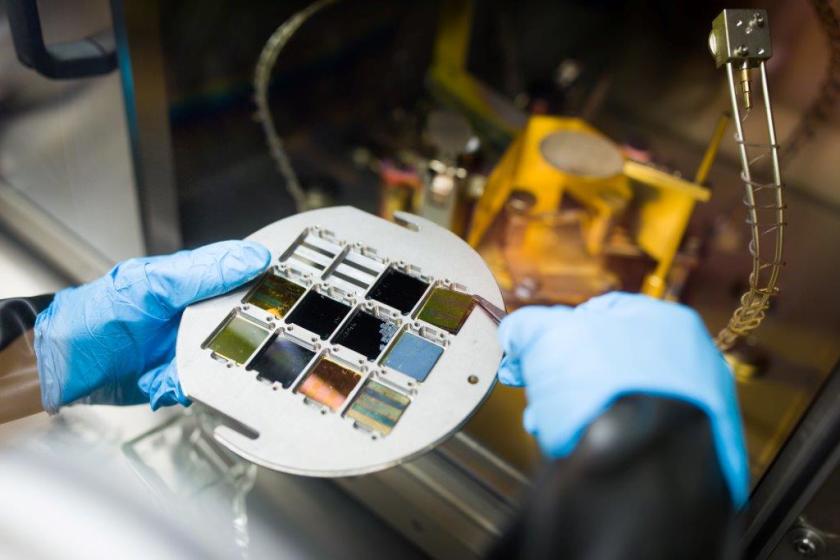Perovskite-silicon solar cell research collaboration hits 25.2% efficiency

Perovskite-based tandem solar cells can achieve now efficiencies better than 25%. © HZB
A 1 cm2 perovskite silicon tandem solar cell achieves an independently certified efficiency of 25.2 %. This was presented this week at an international conference in Hawaii, USA. The cell was developed jointly by HZB, Oxford University and Oxford PV - The Perovskite CompanyTM.
"Perovskite-based tandem solar cells can use light particularly efficiently and therefore offer the opportunity to achieve even higher efficiencies. That is why we have significantly expanded our expertise with the new Helmholtz innovation laboratory HySPRINT," says Prof. Dr. Rutger Schlatmann, Director of the Competence Center Thin Film and Nanotechnology for Photovoltaics Berlin (PVcomB) at HZB. "In our cooperation with Oxford PV, we aim to further optimize perovskite silicon tandem cells, demonstrate their scalability and facilitate their integration into large-area solar modules. For this new result we have optimized our high-efficiency silicon heterojunction bottom cell and developed an optical adaptation to the top cell using a very specific SiOx intermediate layer".
At the World Conference on Photovoltaic Energy Conversion, WCPEC-7 in Waikoloa, Hawaii, tandem solar cells involving perovskites were an important topic: two records have been presented with 25.2% certified efficiency: one from the group of Prof. Christophe Ballif at EPFL/CSEM and one from the consortium HZB/OxfordPV/Oxford University, presented by HZB scientist Dr. Bernd Stannowski. The third one, with 25.0% certified efficiency is a tandem cell developed by an HZB team headed by Dr. Steve Albrecht.
Oxford PV was established in 2010 and has had a close working relationship with Professor Snaith’s research group at the University of Oxford. In January 2018, Oxford PV announced its collaboration with HZB, the leading German research centre focused on energy materials research.
Press Release by Oxford PV
More Information on PVcomB at HZB
More Information on HySPRINT at HZB
More Information on the group Photovoltaics and Optoelectronics at University of Oxford
https://www.helmholtz-berlin.de/pubbin/news_seite?nid=14839;sprache=en
- Copy link
-
New instrument at BESSY II: The OÆSE endstation in EMIL
A new instrument is now available at BESSY II for investigating catalyst materials, battery electrodes and other energy devices under operating conditions: the Operando Absorption and Emission Spectroscopy on EMIL (OÆSE) endstation in the Energy Materials In-situ Laboratory Berlin (EMIL). A team led by Raul Garcia-Diez and Marcus Bär showcases the instrument’s capabilities via a proof-of-concept study on electrodeposited copper.
-
Green hydrogen: A cage structured material transforms into a performant catalyst
Clathrates are characterised by a complex cage structure that provides space for guest ions too. Now, for the first time, a team has investigated the suitability of clathrates as catalysts for electrolytic hydrogen production with impressive results: the clathrate sample was even more efficient and robust than currently used nickel-based catalysts. They also found a reason for this enhanced performance. Measurements at BESSY II showed that the clathrates undergo structural changes during the catalytic reaction: the three-dimensional cage structure decays into ultra-thin nanosheets that allow maximum contact with active catalytic centres. The study has been published in the journal ‘Angewandte Chemie’.
-
Solar cells on moon glass for a future base on the moon
Future settlements on the moon will need energy, which could be supplied by photovoltaics. However, launching material into space is expensive – transporting one kilogram to the moon costs one million euros. But there are also resources on the moon that can be used. A research team led by Dr. Felix Lang of the University of Potsdam and Dr. Stefan Linke of the Technical University of Berlin have now produced the required glass from ‘moon dust’ (regolith) and coated it with perovskite. This could save up to 99 percent of the weight needed to produce PV modules on the moon. The team tested the radiation tolerance of the solar cells at the proton accelerator of the HZB.
